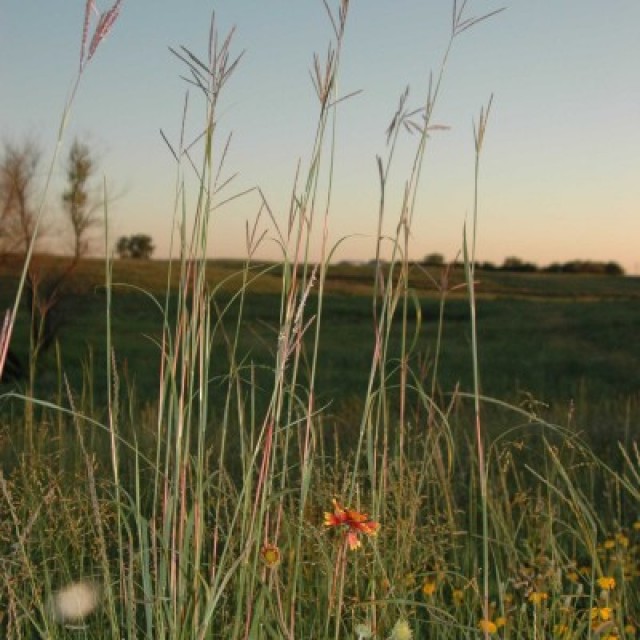COMMON NAME
Big bluestem
SCIENTIFIC NAME
Andropogon gerardii
ALSO KNOWN AS
Turkey foot
Plant family
Grass (Poaceae)
Plant group
Grasses
Big blue stem is a large perennial bunchgrass with roots up to 3 meters deep, native to North America east of the Rocky Mountains.
182 reports
74+
OBSERVERS
182+
OBSERVATIONS
Identification hints
This is one of the largest grasses in the tall grass prairie. Stems can be solid or pithy with a bluish color at the base. It forms a clump with upright stems. The flowers are distinctive in having groups of flowers that branch out from the stem in 3 to 7 'fingers' (digitate) and usually have short fine hairs. Spikelets attached on short stems only have male flowers. In the Great Plains and on dry sites in the northern Midwest, you can also find sand bluestem (Andropogon hallii) which has long straight hairs on the flowering stems and grayish foliage.
Did you know?
Big bluestem is sometimes referred to as an "ice-cream grass" because livestock and wildlife will often eat this species before eating other kinds of grasses. It is valued by homeowners and landscapers who are seeking a drought tolerant grass to provide a native look in their backyards. Big bluestem is the official prairie grass of Illinois. Big bluestem can tolerate a wide range of moisture conditions, which allows it to extend into drier areas like the Great Plains. Its leaves roll up during periods of drought to conserve water.
DISTRIBUTION IN TH U.S.
Alabama
,
Arkansas
,
Arizona
,
Colorado
,
Connecticut
,
Delaware
,
Florida
,
Georgia
,
Iowa
,
Illinois
,
Indiana
,
Kansas
,
Kentucky
,
Louisiana
,
Massachusetts
,
Maryland
,
Maine
,
Michigan
,
Minnesota
,
Missouri
,
Mississippi
,
Montana
,
North Carolina
,
North Dakota
,
Nebraska
,
New Hampshire
,
New Jersey
,
New Mexico
,
New York
,
Ohio
,
Oklahoma
,
Pennsylvania
,
Rhode Island
,
South Carolina
,
South Dakota
,
Tennessee
,
Texas
,
Utah
,
Virginia
,
Vermont
,
Wisconsin
,
West Virginia
,
Wyoming
HABITAT
Big bluestem grows from the east coast to the foothills of the Rocky Mountains and from New Mexico north to Canada. It was the most abundant and tallest grass in the tall grass prairie region of the Midwest and also extended into the Great Plains. It prefers the deep, fertile, dry soils of prairies, plains, and open woods but can also be found on shallow, gravelly ridges during wet periods. Big bluestem does best in undisturbed grasslands, and also in pastures where it is often used for hay.
ATTRIBUTES
Leaves
The lower leaves of big bluestem are 0.25 to 0.5 in (0.6 to 1.27 cm) wide, up to 18 inches long, and are covered with long, soft hairs. Plants have tall slender stems. The grass is green throughout much of the summer with the stem turning to blue-purple as it matures – hence its name.
Flowers
Its flowers are contained in little spikelets that are found densely clustered in pairs on three or more branches from the main stem and are bearded at the tips. One spikelet lays along the branch with male and female flowers, the other spikelet is attached to a small branchlet (pedicel) with male flowers only.
Fruits
The seed heads usually have three (but can have up to seven) spike-like projections which is why big bluestem is sometimes called turkey foot.
Bloom Time
The leaves begin to grow in April in the more southern extents and late May in other areas. In most of its range, flowering occurs from July to September but can be as late as November in the more southern regions.
See Menu
- 2021 Chicago Botanic Garden. All Rights Reserved.
-
Creative Commons
BY-NC-SA 4.0 - Terms of Use
- Privacy Policy
- Data Sharing and Citation Policies
- 2021 Chicago Botanic Garden. All Rights Reserved.



